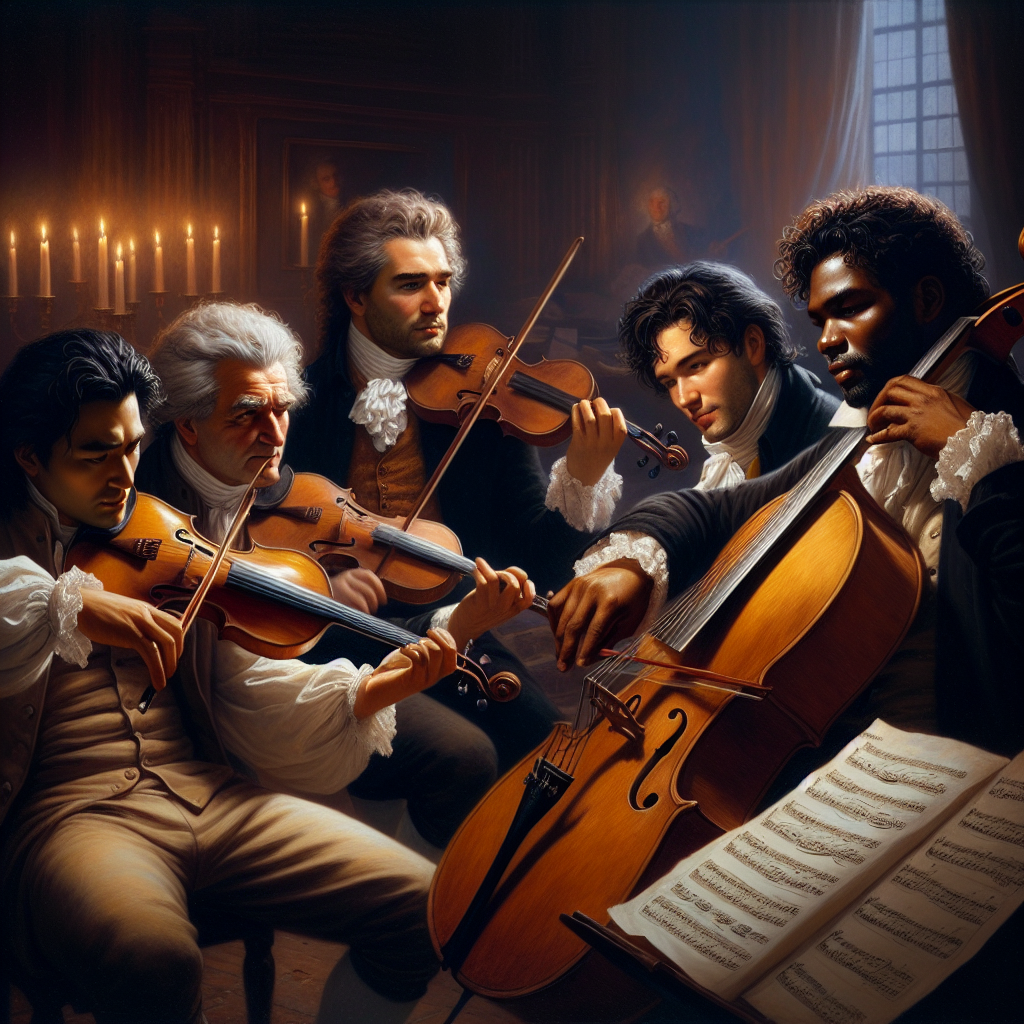
The Late String Quartets – Beethoven’s Legacy
Ludwig van Beethoven remains one of the most revered composers in the history of Western classical music. His works have significantly shaped the development of music, and among his vast repertoire, the late string quartets stand as monumental achievements. Beethoven’s life was marked by profound personal challenges and remarkable creative triumphs. Despite his deteriorating hearing, which ultimately led to complete deafness, Beethoven’s compositional output never ceased to astound the world. In his later years, he composed a series of string quartets that continue to be analyzed, performed, and appreciated for their depth, complexity, and emotional intensity.
The late string quartets, composed during the last years of Beethoven’s life between 1825 and 1826, are often regarded as some of his most profound and introspective works. These quartets, consisting of Op. 127, 130, 131, 132, 133, and 135, mark a distinct departure from his earlier compositions. They encapsulate Beethoven’s musical thought at its most advanced and innovative, weaving together intricate structures, daring harmonies, and a deeply personal expressiveness. These works not only highlight Beethoven’s technical mastery but also reflect his philosophical musings and struggles with his own sense of purpose and mortality.
As we delve into the intricate world of Beethoven’s late string quartets, we will examine their historical context, the innovative elements that set them apart, and their lasting influence on both musicians and listeners. These quartets represent a culmination of Beethoven’s life’s work, offering timeless reflections on humanity, artistry, and the transcendent power of music.
Historical Context and Background
To fully appreciate Beethoven’s late string quartets, it is essential to understand the historical context during which they were composed. By the mid-1820s, Beethoven had already established himself as a leading figure in the world of music. His earlier compositions, including the Third Symphony “Eroica,” the Fifth Symphony, and the piano sonatas, had already pushed the boundaries of musical form and expression. However, this period of his life was also marked by profound personal struggles, including his increasing deafness and isolation from society.
Beethoven’s declining health and hearing profoundly impacted his creative process. Unable to perform or conduct his works, he focused entirely on composition. The isolation and introspection imposed by his condition led to a new level of depth and complexity in his music. Additionally, during this period, Beethoven was influenced by a variety of sources, including his studies of older contrapuntal works and his contemplation of spiritual and metaphysical themes.
The late string quartets reflect Beethoven’s exploration of these introspective and transcendent themes. They are a testament to his ability to communicate profound ideas and emotions through music, despite his physical limitations. The quartets also reveal Beethoven’s continuous pursuit of innovation, as he experimented with unconventional structures, harmonic language, and thematic development. His late quartets challenge traditional musical norms and open new avenues for expression, solidifying his legacy as a visionary composer.
Opus 127 – Quartet in E-flat Major
The first of Beethoven’s late string quartets, Op. 127 in E-flat Major, represents a turning point in his compositional style. Composed in 1825, this quartet was dedicated to Prince Nikolai Galitzin, a Russian nobleman and avid supporter of Beethoven’s music. The quartet’s premiere met with mixed reactions, but its significance as a groundbreaking work soon became evident.
From the opening bars of the first movement, Beethoven establishes a sense of grandeur and expansiveness. The introductory chords are reminiscent of a symphonic overture, setting the stage for the intricate interplay of themes and variations that follow. The second movement, marked Adagio, is a lyrical and meditative exploration, showcasing Beethoven’s ability to convey deep emotional nuances.
The third movement, a lively Scherzo, contrasts with the introspective nature of the previous movement. Its rhythmic complexity and playful character reflect Beethoven’s innovative approach to traditional forms. The quartet concludes with a spirited and jubilant Finale, bringing a sense of resolution to the thematic journey.
Op. 127 exemplifies Beethoven’s blending of lyrical beauty with structural ingenuity. Its harmonic richness and inventive use of texture set a new standard for string quartet composition. This work serves as a powerful introduction to the evolving language of Beethoven’s late quartets, offering a glimpse into the profound ideas and emotions that would characterize his subsequent works.

Opus 130 – Quartet in B-flat Major
Beethoven’s Op. 130 in B-flat Major, composed in 1825-1826, is one of his most enigmatic and ambitious string quartets. This work stands out not only for its impressive length but also for its unconventional structure and emotional depth. Originally consisting of six movements, Op. 130 showcases Beethoven’s willingness to push the boundaries of classical form.
The first movement, marked Adagio ma non troppo – Allegro, begins with a sense of serene beauty before transitioning into a lively and energetic Allegro. The second movement, a playful and rhythmic Presto, offers a stark contrast to the introspective nature of the first. The third movement, Andante con moto ma non troppo, is a lyrical and tender exploration, highlighting Beethoven’s gift for crafting deeply expressive melodies.
The fourth movement, Alla danza tedesca: Allegro assai, introduces a folk-like dance character, while the fifth movement, Cavatina: Adagio molto espressivo, is one of Beethoven’s most poignant and emotionally charged compositions. The original sixth movement, the Große Fuge (Great Fugue), is a complex and intense exploration of contrapuntal writing. However, due to its demanding nature, Beethoven later replaced it with a lighter and more accessible finale, marked Allegro.
Op. 130 is a testament to Beethoven’s ability to blend contrasting elements into a cohesive whole. Its structural innovation and emotional depth continue to inspire and challenge musicians and audiences alike. This quartet exemplifies Beethoven’s unyielding commitment to artistic exploration, even in the face of personal adversity.
Opus 131 – Quartet in C-sharp Minor
Often regarded as one of Beethoven’s greatest achievements, Op. 131 in C-sharp Minor is a towering masterpiece of the string quartet repertoire. Composed in 1826, this extraordinary work is notable for its continuous, seven-movement structure, unconventional key relationships, and profound emotional depth. Beethoven himself considered it one of his finest creations, referring to it as his most personal and heartfelt composition.
The quartet opens with a mournful and introspective Adagio ma non troppo e molto espressivo, setting the stage for a journey through a wide range of emotions. The subsequent Allegro molto vivace introduces a contrasting burst of energy and vitality. The third movement, a brief and enigmatic Allegro moderato, serves as a transition to the central heart of the quartet.
The Andante ma non troppo e molto cantabile, marked by its lyrical and flowing character, stands as the emotional core of Op. 131. Its serene beauty and expressive melodies evoke a sense of transcendence. The following Presto injects a lively and rhythmic energy, leading into the contemplative Allegro molto e vivace.
The final movement, marked Allegro, is a triumphant and exhilarating conclusion, bringing a sense of resolution to the quartet’s emotional journey. Op. 131 is a profound meditation on the human experience, encompassing a wide spectrum of emotions and states of mind. Its seamless integration of disparate movements and thematic coherence exemplify Beethoven’s mastery of form and his ability to convey profound philosophical and emotional insights through music.
Opus 132 – Quartet in A Minor
Beethoven’s Op. 132 in A Minor, composed in 1825, stands as a powerful testament to his resilience and creative spirit. This quartet is deeply personal, reflecting Beethoven’s struggles with illness and his eventual recovery. The work’s central movement, the Heiliger Dankgesang (Holy Song of Thanksgiving), is a sublime expression of gratitude and renewal.
The first movement, marked Assai sostenuto – Allegro, opens with a somber and introspective theme, gradually building in intensity and complexity. The second movement, Allegro ma non tanto, introduces a lively and rhythmic character, offering a stark contrast to the contemplative nature of the first.
The Heiliger Dankgesang, marked Molto adagio – Andante, is the emotional heart of Op. 132. This movement is a profound and deeply spiritual expression of Beethoven’s gratitude for his recovery from illness. Its meditative and hymn-like quality transports listeners to a place of introspection and transcendence. The following Alla marcia, assai vivace, injects a burst of energy and vitality, serving as a bridge to the quartet’s final movement.
The quartet concludes with a spirited and triumphant Allegro appassionato, bringing a sense of resolution and closure. Op. 132 is a work of profound emotional depth, showcasing Beethoven’s ability to convey complex and deeply personal experiences through music. Its exploration of themes of suffering, gratitude, and renewal make it one of the most moving and enduring works in the string quartet repertoire.
Conclusion
Beethoven’s late string quartets stand as a testament to his unparalleled genius and his ability to transcend personal adversity through the power of music. These works represent a culmination of his life’s journey, offering profound insights into the human condition and the transcendent nature of art. From the grand and expansive Op. 127 to the deeply introspective Op. 131, each quartet reflects Beethoven’s unyielding commitment to artistic exploration and his ability to communicate profound ideas and emotions through music.
The late string quartets continue to captivate and inspire musicians and audiences worldwide. Their complexity, emotional depth, and structural innovation challenge traditional musical norms and open new avenues for expression. Through these quartets, Beethoven not only redefined the boundaries of the string quartet genre but also left an enduring legacy that continues to influence and inspire generations of musicians and listeners.
As we reflect on the remarkable achievements of Beethoven’s late string quartets, we are reminded of the transformative power of music. These works invite us to delve into the deepest recesses of the human soul, exploring themes of suffering, resilience, gratitude, and transcendence. Beethoven’s late string quartets are not merely compositions; they are profound meditations on the human experience, offering timeless reflections on the artistry, complexity, and beauty of life.